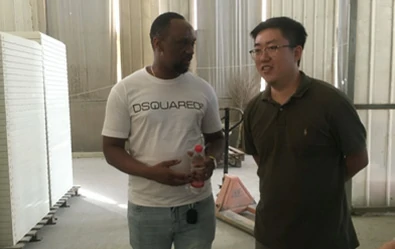loading...
- No. 9, Xingyuan South Street, Dongwaihuan Road, Zaoqiang County, Hengshui, Hebei, China
- admin@zjcomposites.com
- +86 15097380338
- Welcome to visit our website!
frp pressure vessel
Understanding FRP Pressure Vessels A Comprehensive Overview
Fiber Reinforced Polymer (FRP) pressure vessels have gained significant traction in various industries due to their unique properties and advantages compared to traditional materials like steel and aluminum. This article provides a detailed insight into FRP pressure vessels, exploring their benefits, applications, design considerations, and future prospects.
What are FRP Pressure Vessels?
FRP pressure vessels are containers designed to hold gases or liquids at a pressure substantially different from the ambient pressure. These vessels are manufactured from a composite material made of a polymer matrix reinforced with fibers, commonly glass or carbon fibers. The incorporation of these fibers enhances the strength, durability, and structural integrity of the vessels, making them suitable for high-pressure applications.
Advantages of FRP Pressure Vessels
1. Lightweight One of the most significant advantages of FRP vessels is their lightweight nature. Compared to steel vessels, FRP units can weigh up to 75% less, facilitating easier handling, installation, and transportation.
2. Corrosion Resistance Traditional metals are often susceptible to corrosion, especially in harsh environments. FRP materials, however, provide exceptional resistance to a variety of chemicals, making them ideal for industries such as chemical processing, water treatment, and oil and gas.
3. Thermal Insulation FRP vessels have excellent thermal insulation properties. This feature is particularly beneficial for applications involving temperature-sensitive materials, ensuring that the stored substances maintain their desired temperatures.
4. Design Flexibility The manufacturing process of FRP allows for greater design flexibility compared to conventional materials. Engineers can tailor the vessel's shape, size, and structural characteristics to meet specific operational needs.
5. Cost-Effective in the Long Run Although the initial cost of FRP pressure vessels may be higher than traditional materials, their longevity, low maintenance requirements, and energy efficiency often lead to cost savings over time.
Applications of FRP Pressure Vessels
FRP pressure vessels are versatile and used across various sectors, including
frp pressure vessel

- Chemical Industry Holding and transporting aggressive chemicals without the risk of contamination or corrosion. - Water Treatment Used in filtration systems and storage for desalination plants where exposure to various chemicals is common. - Oil and Gas Effective in applications involving crude oil storage and transportation, especially in corrosive environments. - Pharmaceuticals Support the safe storage and transport of sensitive products that require sterile conditions, free from contamination.
Design Considerations
When designing and manufacturing FRP pressure vessels, several essential factors must be considered
1. Material Selection Depending on the intended application, the choice of polymer matrix and reinforcing fibers is crucial. Glass fibers are common due to their strength and cost-effectiveness, while carbon fibers are preferred for applications requiring higher strength-to-weight ratios.
2. Pressure Rating Engineers must ensure that the vessel meets the required pressure specifications. This involves calculating the internal and external pressure conditions and designing the vessel accordingly.
3. Safety Factors Safety is paramount in pressure vessel design. Therefore, a proper understanding of regulatory standards and safety factors is essential to avoid catastrophic failures.
4. Testing and Certification FRP pressure vessels must undergo rigorous testing to ensure reliability and compliance with industry standards. This may include hydrostatic tests, burst tests, and fatigue tests to confirm performance under various conditions.
Future Prospects
As industries continue to demand more efficient, sustainable, and cost-effective solutions, the use of FRP pressure vessels is likely to expand. Innovations in composite materials and production methods will enhance performance, allowing vessels to withstand higher pressures and temperatures. Moreover, the increasing focus on environmental sustainability will drive the adoption of these materials, as they can reduce the carbon footprint associated with transportation and energy consumption.
Conclusion
FRP pressure vessels represent a significant advancement in materials engineering, providing numerous advantages over traditional materials. Their lightweight nature, corrosion resistance, and versatility make them essential in various applications across different industries. As technology progresses, the potential for FRP pressure vessels to transform conventional approaches in manufacturing and storage is immense, paving the way for future innovations in engineering solutions.
-
The Rise of FRP Profiles: Strong, Lightweight, and Built to LastNewsJul.14,2025
-
SMC Panel Tanks: A Modern Water Storage Solution for All EnvironmentsNewsJul.14,2025
-
GRP Grating: A Modern Solution for Safe and Durable Access SystemsNewsJul.14,2025
-
Galvanized Steel Water Tanks: Durable, Reliable, and Ready for UseNewsJul.14,2025
-
FRP Mini Mesh Grating: The Safer, Smarter Flooring SolutionNewsJul.14,2025
-
Exploring FRP Vessels: Durable Solutions for Modern Fluid HandlingNewsJul.14,2025
-
GRP Structures: The Future of Lightweight, High-Performance EngineeringNewsJun.20,2025
